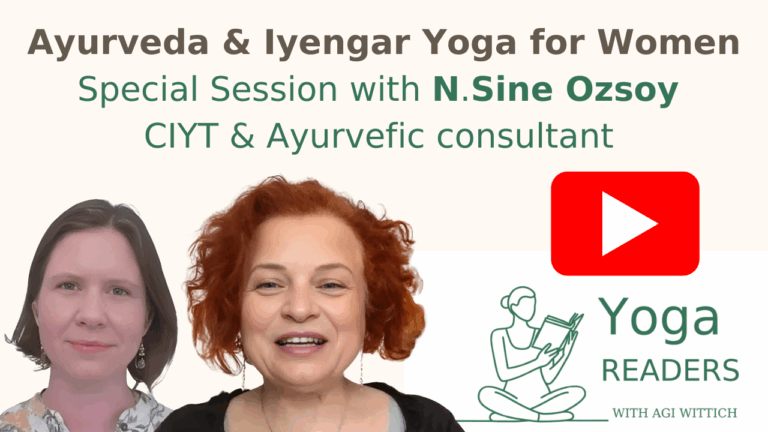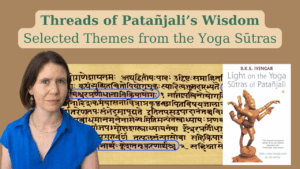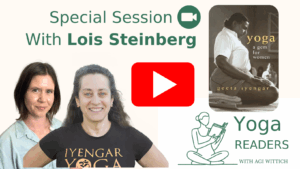
From Book Session: Special Session with Lois Steinberg
Have you noticed how certain yoga poses energize you while others bring calm? What if the ancient sciences of Yoga and Ayurveda could help you understand your unique constitution and navigate life’s transitions with greater ease?
“Ayurveda and yoga allow us to find our inner compass in this crazy world.” — Sine Ozsoy
In our recent Yoga Readers session, we had the privilege of hosting Sine Ozsoy, an Ayurvedic practitioner and Level 3 Certified Iyengar Yoga teacher with over 32 years of experience. Sine shared profound insights on integrating Ayurveda and Iyengar Yoga for women’s health as we explored Geeta Iyengar’s seminal book, “Yoga: A Gem for Women.” What follows may transform not just your yoga practice, but your entire approach to health and wellbeing.
The Sister Sciences: Yoga and Ayurveda
Āyurveda (आयुर्वेद, the ancient Indian science of life and longevity) is far more than the wellness methodology it’s often reduced to in modern times. As Sine eloquently explained, “One of the most unfair things that is being done to Ayurveda right now is that it is used as a wellness methodology, whereas this is a huge science that gives you a holistic approach to how to live healthily in this world.”
Geeta Iyengar, in “Yoga: A Gem for Women,” describes Ayurveda as recognizing that “the body consists of three fundamental elements: doṣa (दोष, bodily humors that govern physiological functions) or humours, dhātu (धातु, seven essential tissues that form the body’s structure) or essential ingredients, and mala (मल, waste products that must be properly eliminated) or impurities.” She explains that “the doṣas perform the physiological and physiochemical activities of the body” and that these elements “are said to be in a state of equilibrium in the case of good health. When the equilibrium is disturbed, disease sets in.”
Sine emphasized that Yoga (योग, union or integration of body, mind and spirit) and Ayurveda are sister sciences sharing the same goal: “As a person, we create union — union between the micro and macro cosmos.” Both traditions offer complementary paths to this inner harmony.
Understanding the Doshas and Gunas
The doṣas — Vāta (वात, the principle of air and ether that governs movement), Pitta (पित्त, the principle of fire and water that governs transformation and metabolism), and Kapha (कफ, the principle of earth and water that governs structure and cohesion) — form the foundation of Ayurvedic understanding of individual constitution. Sine provided a beautiful explanation of how these energies manifest in our bodies and personalities:
“If you see a Vāta person walking from behind, literally you can see the wings in their ankles because they’re like hopping. And if you see a Pitta person, they’re generally walking with the head leading. Whereas a Kapha person is very gentle, looking everywhere. They’re solid, they’re together.”
Beyond the doshas, Sine introduced us to the guṇas (गुण, fundamental qualities or attributes that characterize all substances and experiences) — the 20 fundamental qualities organized as 10 opposing pairs that characterize all substances and experiences. These include:
Sine emphasized a key Ayurvedic principle: “Like for like, opposites heal.” If you’re feeling heavy (Guru), you need something light (Laghu) to create balance. She offered practical examples: “If it is cold, you keep yourself hot. If you have the cold feeling, you eat soup instead of salad. And if it is really snowing outside, you don’t have a quinoa salad, you have soup just like your grandmother did.”
Women’s Health Through Life’s Milestones
Both Sine and Geeta Iyengar recognize the unique challenges women face throughout their lives. In “Yoga: A Gem for Women,” Geeta identifies “three important stages in a woman’s life beginning with youth, passing through middle age, and ending in old age: Menstruation, Pregnancy and delivery, Menopause.”
Menstruation
For menstruation, Sine advocated gentle practices and emphasized the importance of listening to one’s body. She recommended eating soft, light foods and suggested that the madhura rasa (मधुर रस, the sweet taste which is nourishing and grounding) is important during this time. “We need to have, for example, rice dal, that will combine the sweet and the protein, and we should have less animal protein if we are having it at all, and more plant-based protein to support our body and practice.”
Geeta notes in her book that “Yogāsanas (योगासन, yoga postures that develop strength, flexibility and awareness) and prāṇāyāma (प्राणायाम, conscious regulation of the breath to influence vital energy) offer great help at puberty when the body is changing to womanhood.” She specifically recommends “inverted postures and backbends” as “useful for stimulating the pituitary gland” and “forward bends” as “effective as pure blood is supplied to the pelvic organs.”
Pregnancy
On pregnancy, Geeta writes, “A woman who has looked after her health will reap the reward by having a healthy pregnancy and producing a healthy child.” She dispels common misconceptions: “There is a fear in the minds of some women that if Yoga is done during pregnancy, it may lead to miscarriage. This is, however, nothing but an old wives’ tale.”
She recommends specific asanas that “expand the cavity of the pelvic region creating space inside the uterus, ensuring proper blood circulation and adequate room for the movement of the child.”
Menopause
Sine beautifully reframed menopause as the “golden years,” explaining: “Can you not feel it? You are full of energy. You have abundant love and generosity, and your mind is clear because PMS is over. Thank God! So you have all this clarity around you, and people are looking up to you and asking for your wisdom. Of course, it’s golden years — it’s fantastic! What else could it be?”
Geeta acknowledges in her book that “women have to face disturbances at the stage of menopause” but emphasizes that “practice of Yoga asanas is extremely beneficial, as it calms the nervous system and brings equipoise.”
Living in Rhythm
A central theme in Sine’s talk was the importance of living in harmony with natural cycles — both daily circadian rhythms and seasonal changes. She explained how each time of day corresponds to a different dosha:
Understanding these cycles helps us optimize our activities. As Sine explained, if you struggle to get up in the morning during Kapha time (which is naturally heavy and slow), it indicates a Kapha imbalance that can be countered with energizing practices.
Adhering to dinacharya (दिनचर्या, daily routine aligned with natural rhythms) and ritucharya (ऋतुचर्या, seasonal routine that adapts to nature’s changes) allows us to maintain balance throughout the day and year. These practices acknowledge that our bodies are not separate from nature but part of its rhythmic flow.
Yoga Practice for Different Constitutions
One of the most practical aspects of Sine’s teaching was how different yoga practices benefit different constitutional types:
Geeta Iyengar confirms this approach, stating that “all the sheaths are interdependent and interpenetrating, reaching from outer cover to inner core. During the performance of Yogāsanas and Prāṇāyāma, total attention is brought to bear on all the sheaths, from the anatomical to the spiritual and vice versa.”
Finding Your Inner Compass
Perhaps the most profound message from Sine’s talk was about using Ayurveda and Yoga to find our inner compass in a world that often pulls us away from our natural wisdom.
“Feed your hunger, not your appetite,” she advised, distinguishing between our body’s true needs and our mental cravings. “The appetite says ‘It’s 9:00 PM and I want a chocolate cake.’ That’s not your appetite, that’s your mind.”
Geeta Iyengar reminds us in her book that “health is defined as equilibrium among five factors: (i) the doṣas – the humours; (ii) the dhātus – seven juicy secretions from the ingredients of the body; (iii) Agni (अग्नि, digestive fire that transforms food into nourishment), i.e., proper functioning of digestion and elimination of waste matter, which is called the metabolism of the body; (iv) clarity or purity of the senses; and (v) tranquillity and peace of the mind.”
This holistic understanding of health guides us back to ourselves, helping us recognize what we truly need for balance in each moment. Through regular sādhana (साधना, dedicated practice with spiritual intention), we cultivate svastha (स्वस्थ, established in oneself, the state of optimal health where body and mind are in harmony).
Conclusion
As we continue our exploration of Geeta Iyengar’s “Yoga: A Gem for Women,” Sine’s insights remind us that these ancient traditions offer profound wisdom for modern women navigating life’s many transitions. By understanding our unique constitution and learning to work with natural cycles rather than against them, we can cultivate lasting health, clarity, and inner peace.
In Sine’s parting words: “You can slowly bring small rules of Ayurveda into your life, very slowly. And just observe how it actually transforms you forever.”
Reflecting on Your Journey
As you consider the wisdom shared from Sine Ozsoy and Geeta Iyengar, take a moment to reflect on your own relationship with these ancient practices:
Have you noticed how your energy fluctuates throughout the day? When do you feel most alert? When do you feel heaviest? How might aligning your activities with the appropriate dosha times enhance your wellbeing?
Whether you’re experiencing menstruation, pregnancy, or approaching menopause, how can you adapt your yoga practice to support your body’s changing needs? What practices bring you balance during these transitions?
Consider a physical or emotional state that feels challenging right now. Using the principle “like for like, opposites heal,” what qualities might bring you back to balance? If you’re feeling scattered (Vata), what grounding practices might help? If you’re feeling inflamed (Pitta), what cooling practices could soothe you?
What practices help you distinguish between your body’s true hunger and your mind’s cravings or appetites? How can you cultivate the ability to listen more deeply to your inner wisdom?

A course of selected themes from the Yoga Sutras with Dr. Agi Wittich The Yoga Sūtras of Patañjali are the philosophical heart of yoga.

In a recent Yoga Readers session, Dr. Lois Steinberg opened her teaching archives and personal memories, sharing stories that span four decades of study
Agi Wittich is a yoga practitioner since two decades, and is a certified Iyengar Yoga teacher. Wittich studied Sanskrit and Tamil at the Hebrew University of Jerusalem, Israel, completing a PhD with a focus on Hinduism, Yoga, and Gender. She has published academic papers exploring topics such as Iyengar yoga and women, the effects of Western media on the image of yoga, and an analysis of the Thirumanthiram yoga text.